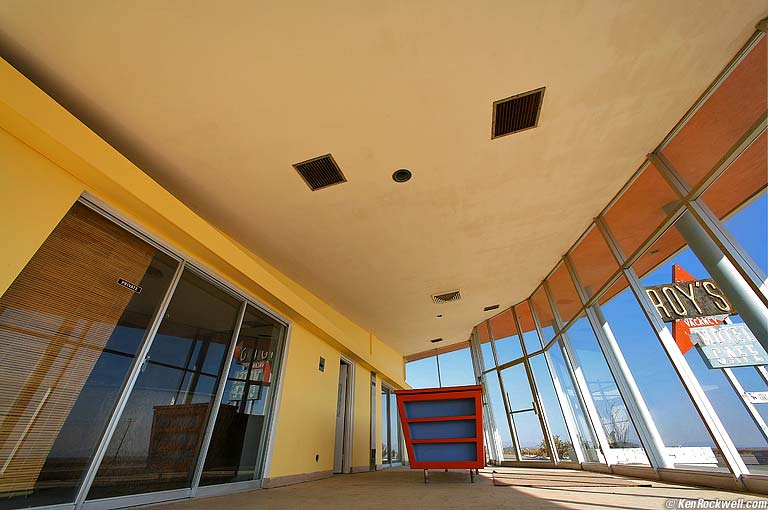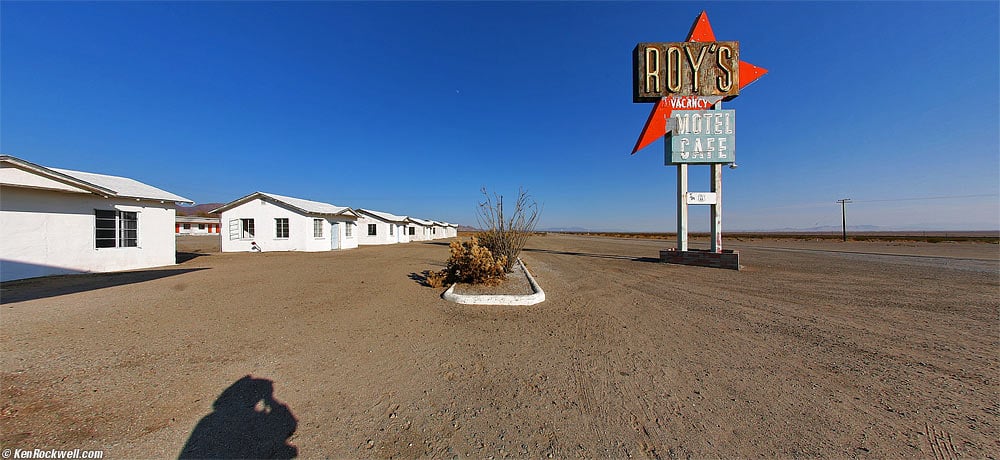Canon 5D, Canon 15mm Fisheye, f/8 @ 1/320, ISO 50, hand-held (tech details).
There isn't much out in the desert. You go for miles between seeing anything. See the tiny white dot in the middle of the sky? That's the almost-full moon.
I shouldn't have blown out the white buildings. Sorry, I missed that. I usually don't on my Nikons, which have far superior LCDs and histogram displays.
I used DxO Optics Pro software to stretch my fisheye image back to a conventional, flat image. The image from the camera was the usual useless curvy image. Next Photo >>
Next Photo >>
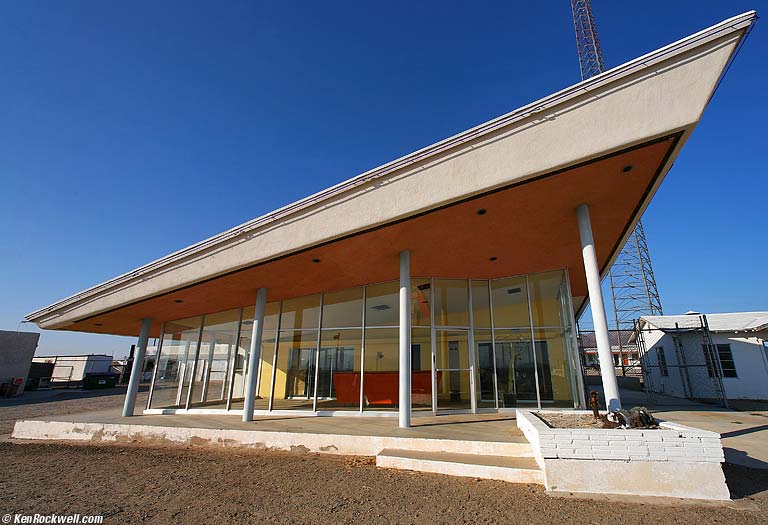
Roy's Spaceport, Amboy, California.
Canon 5D, 14mm f/2.8L, f/11 @ 1/100, ISO 50, hand-held (tech details).
I love how I can use my 14mm lens to stretch things out. It's exactly the opposite effect from a fisheye, which squishes things together at the sides.
I cheated a little here - this building really does tilt up to the right. I used my 14mm lens to exaggerate this. Next Photo >>
Next Photo >>
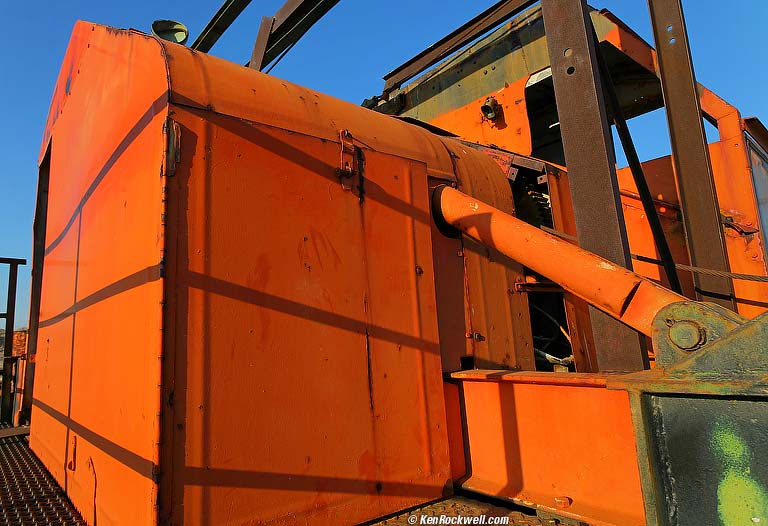
Orange, Amboy, California.
Canon 5D, 17-40mm f/4L at 21mm, f/8 @ 1/125, ISO 50, hand-held (tech details).
Photos of old trucks become slightly less of a cliché when photographed more closely. Next Photo >>
Next Photo >>

A Truckload of Clichées, Amboy, California.
Canon 5D, 14mm f/2.8L, f/11 @ 1/100, ISO 50, hand-held (tech details).
This old Chevrolet is hauling a truckload of photographic clichées to my gallery pages. I love the orange color as highlighted in the afternoon light. My 14mm lens weirded it out a little, making it more of a cliché. The nude models were busy posing on the other trucks, sorry. Next Photo >>
Next Photo >>
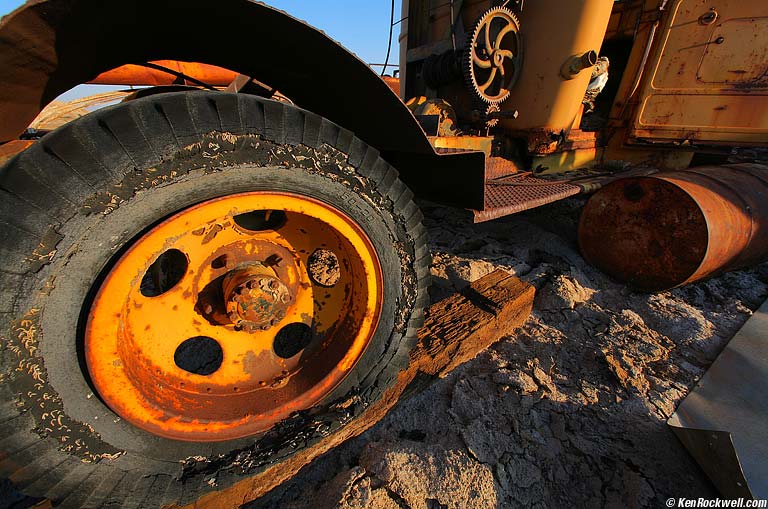
Miners' Boneyard, Amboy, California.
Canon 5D, 14mm f/2.8L, f/11 @ 1/40, ISO 50, hand-held (tech details).
I'm a sucker for the edge-sucking effects of ultra-wide lenses. This is why the wheel looks pulled to the left, a deliberate part of the composition.
14mm lenses are very difficult to use well. Each half-inch (1cm) change in camera position makes a huge change in the perspective and composition. The tiny peephole of my 5D's viewfinder makes it hard to see the entire composition while shooting, so often I don't use the entire frame as is critical with ultra-wide lenses. It took me several tries to get this to fill the frame. Next Photo >>
Next Photo >>
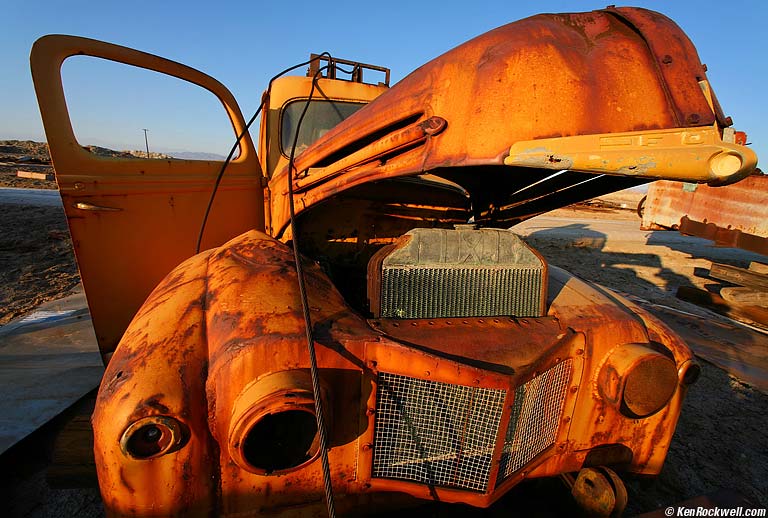
Cliché, Amboy, California.
Canon 5D, 14mm f/2.8L, f/13 @ 1/40, ISO 50, hand-held (tech details).
I used my 14mm lens on my full-frame camera to make the hood fly out from the rest of the truck. A 17mm lens (same as a 10-12mm lens on an ordinary Nikon or Canon DSLR) would have had much less of an effect. A normally wide lens would have rendered this as just another cliché with an open hood. Roll your mouse over the image to see it as shot at the widest setting of most normal cameras, a 37mm lens. Next Photo >>
Next Photo >>
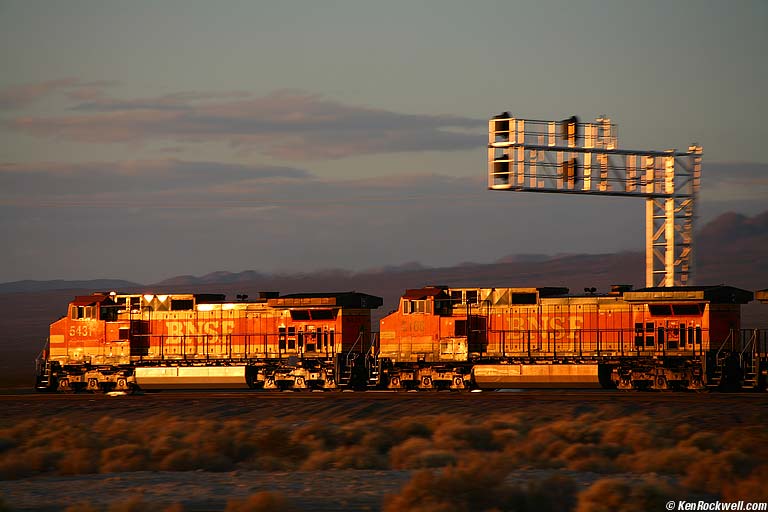
Speeding Locomotive, Amboy, California.
Canon 5D, Canon 70-300mm f/4-5.6 IS USM at 270mm, f/8 @ 1/100, ISO 50, hand-held (tech details).
The Canon 70-300 IS works great for panning, and I haven't even read the instructions on how to use it. I used it in IS MODE I, and I suspect that I should have used IS MODE II for panning. I don't know, but I do know this and other panned shots of moving locomotives worked great. Next Photo >>
Next Photo >>
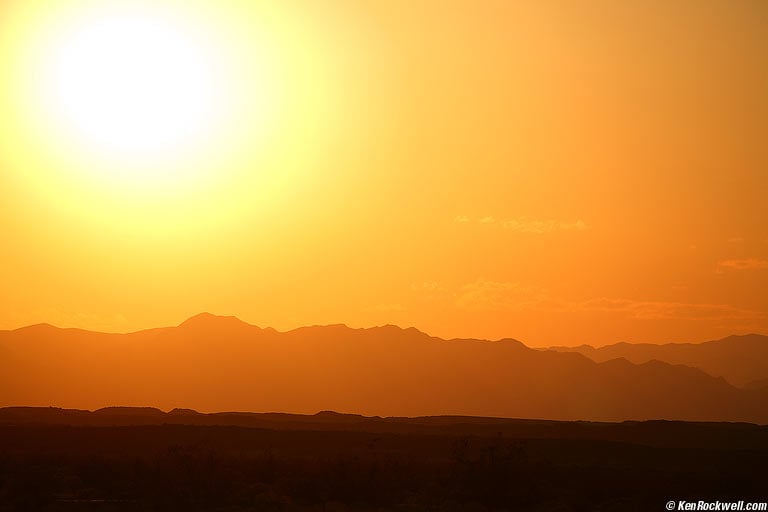
Sunset, Amboy, California.
Canon 5D, Canon 70-300mm f/4-5.6 IS USM at 300mm, f/8 @ 1/500, ISO 50, hand-held (tech details).
Another popular cliché is the static sunset, as seen here over the desert hills. This is nice, but would have been nicer if I caught it with something like a nude model in the foreground. The models were posing elsewhere.
This is nice: I'm pleasantly surprised that there isn't any flare or ghosting in the Canon 70-300mm IS. Other lenses often put ghost images in the lower right, if the disc of the sun is in the upper left. Next Photo >>
Next Photo >>
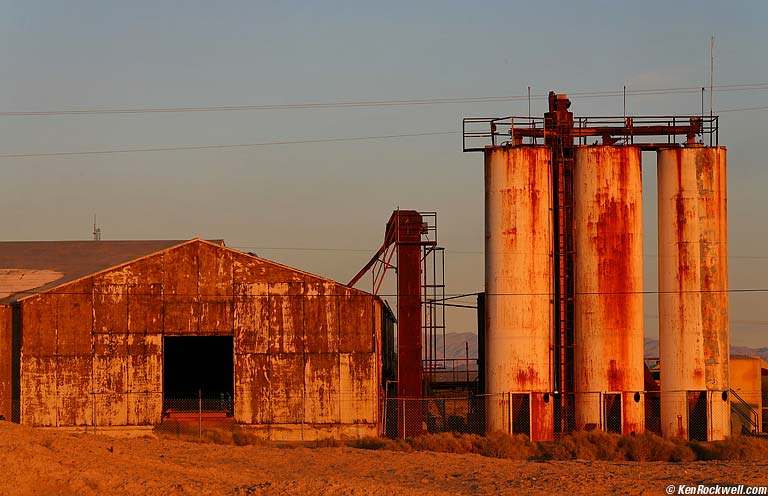
Boring Shot of Chemical Plant, Amboy, California.
Canon 5D, Canon 70-300mm f/4-5.6 IS USM at 120mm, f/11 @ 1/80, ISO 50, hand-held (tech details).
This is the shot most people make. Most people prefer to zoom in instead of walking closer.
There is great light on the stacks, but a boring gray sky and no dynamics. At this distance the color of the stacks is slightly muted by the atmospheric conditions.
Your feet are the most important equipment next to your brain - use them. Next Photo >>
Next Photo >>
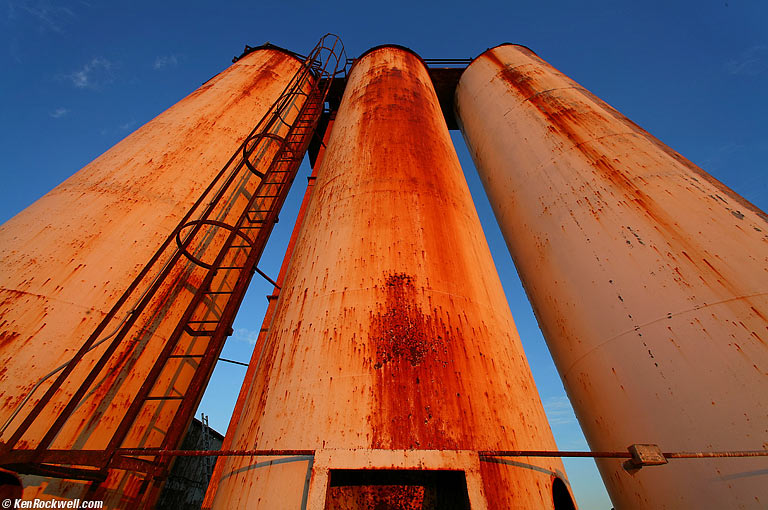
Chemical Plant, Amboy , California.
Canon 5D, 14mm f/2.8L, f/11 @ 1/25, ISO 50, hand-held. (tech details.)
These are the same three stacks in the shot above. The only difference was walking up to the stacks and looking up with an ultra-wide lens. Camera settings were the same; exposure was less.
There is stronger color in the stacks because we're not looking through 300 feet of atmosphere.
The sky is much bluer because we're looking up at the blue, and not at the gray of the horizon. The sky is blue at the top of the image, and gray at the bottom. The telephoto shot only saw the gray part of the sky, and the telephoto lens magnifies that small part of the sky to fill the image above.
Instead of a boring static shot, we've added gesture and motion by looking up with an ultra wide angle lens. This is why the bottom of the shot looks horizontally at the bottom of the stacks, and the top looks straight up.
It's not the 14mm lens which gives this perspective. It's the fact that I'm only a couple of feet away from the stacks. Using a 14mm lens and not moving dangerously close would give a crappier image with even smaller stacks.
Position is critical to using ultra wide lenses. You have to force yourself to get dangerously and annoyingly close to your subjects and pay rapt attention to your viewfinder. It is also critical to hold the camera level. It took several tries to get the baseline horizontal. You can fix minor Dutch (crooked horizons) in Photoshop, but you cannot correct point of view if you didn't get close enough. Next Photo >>
Next Photo >>
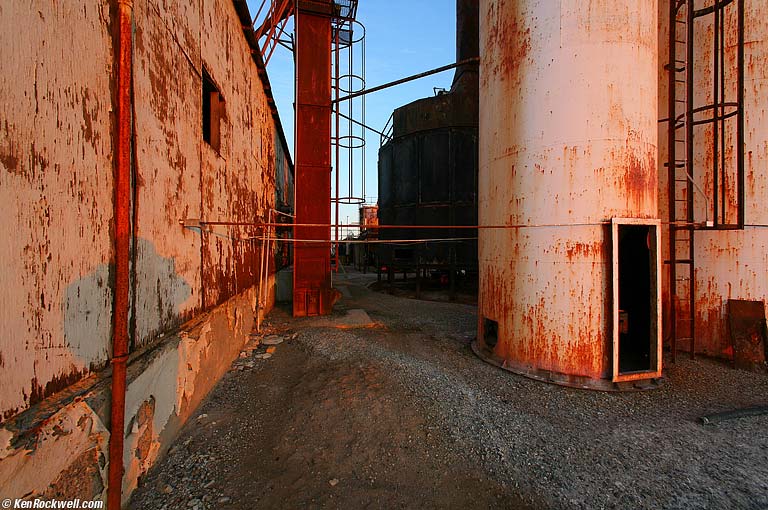
View Camera Shot, Chemical Plant, Amboy, California.
Canon 5D, 14mm f/2.8L, f/11 @ 1/30, ISO 200, hand-held. (tech details.)
This is the shot most view camera users would have gotten. They keep their beds flat and their film vertical so all the vertical lines are parallel. The pipe to the left is bent; it's not camera misalignment.
I shot this, as everything, hand held on my digital camera. We only has 5 minutes of good light - it's already faded in this shot. That's only 300 seconds, total, of good light. I can't set up a tripod that quickly. If I tried, I only would have gotten one shot, not the many different compositions I shot in great light. I'm not showing everything here. Next Photo >>
Next Photo >>
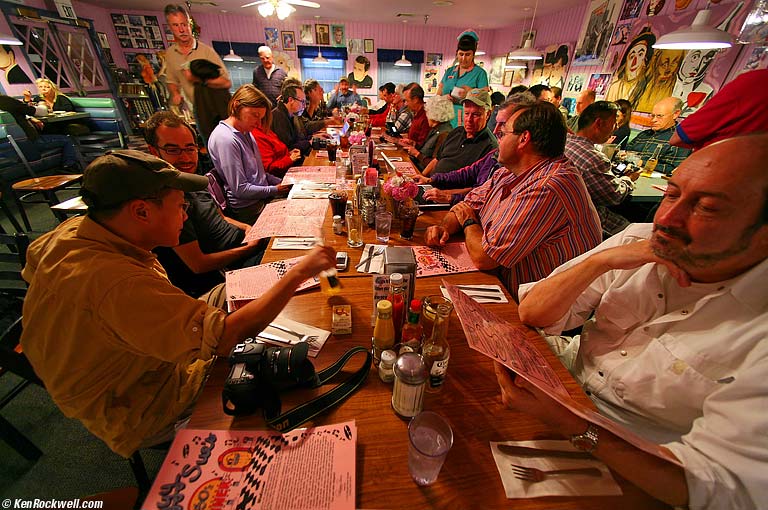
The Feast at Peggy Sue's, Yermo, California.
Canon 5D, 14mm f/2.8L, f/4 @ 1/13, ISO 800, hand-held. (tech details.)
Peggy Sue's is a roadside diner built in 1954. It's been expanded since. It's loaded with 1950's entertainment memorabilia, but no old cars. My 14rmm lens makes this room look much larger than it is. The restaurant has many other rooms to compensate for this. Next Photo >>
Next Page of Photos >>
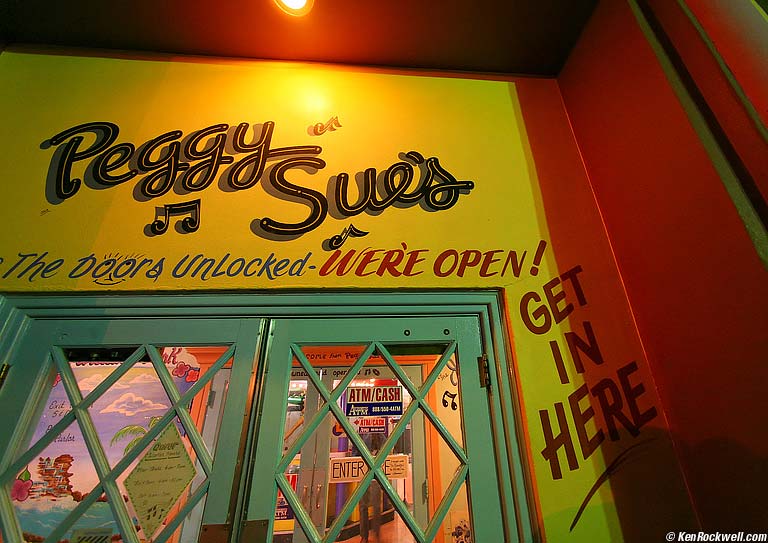
Peggy Sue's, Yermo, California.
Canon 5D, 14mm f/2.8L, f/4 @ 1/13, ISO 1,600, hand-held. (tech details.)
Next Page of Photos >>
Home
Search
Gallery How-To Books
Links Workshops About Contact
